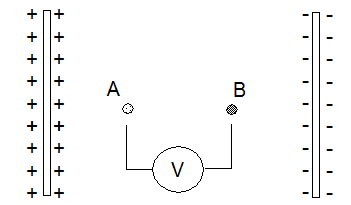back to Circuits (home page)
3.1. Voltage and surface charges
3.1.Quantitative determination of potential difference or voltage
In physics it is always necessary that a term like potential difference is not only described qualitatively. It also needs a method to be measured quantitatively.
For such a quantitative determination it is not possible to measure directly the surface charges or the accompanying Coulomb forces. The density of the additional electrons on the surface of current carrying conductors are in general rather small and are depending on different geometrical factors. The same holds for the gradients of their density.
Independent of such external factors, however, is the work done by these forces or in other words the transformation of electric energy which results from a certain current driven by a certain voltage or potential difference.
This offers the possibility to relate voltage or potential difference between two points A and B to the amount of electric energy E that is transformed when a certain amount of charge q is moved from A to B. In mathematical form: V = E/q.
Numerically voltage or potential difference is equal to the amount of electric energy which is transformed if a unit of 1 Coulomb is moved from A to B.
The unit of voltage or potential difference is 1 Volt, abbreviated as V, in honour of the Italian physicist Alessandro Graf von Volta (1745-1827).
3.2. Energy transformation in relation to voltage and current
Given an electric current of strength I = q/t driven by an applied voltage V = E/q between the points A and B.
If this currents flows from A to B during a time period t, an amount of charge
q = I * t will be transported from A to B.
For the transformation of electric energy it follows:

3.3. Extended definition of voltage between points in space
The definition of voltage as E/q makes it possible to define a voltage not only when charges are separated but also between two points A and B in an empty space between separated charges, where A and B themselves do not carry any charges.

Fig.7: Potential difference between 2 neutral points
As shown in the figure above there will be a difference between A and B in respect to the distance to the external charges and therefore energy will be transformed if a charge is moved from A to B.
Based on the definition V = E/q we can define a voltage between A and B, even though there are no separated charges at A and B.
The two locations A and B differ in this case not because of different density in surface charges but because of different distances to separated charges.
back to Circuits (home page)

3.3. Extended definition of voltage between points in space
The definition of voltage as E/q makes it possible to define a voltage not only when charges are separated but also between two points A and B in an empty space between separated charges, where A and B themselves do not carry any charges.

Fig.7: Potential difference between 2 neutral points
As shown in the figure above there will be a difference between A and B in respect to the distance to the external charges and therefore energy will be transformed if a charge is moved from A to B.
Based on the definition V = E/q we can define a voltage between A and B, even though there are no separated charges at A and B.
The two locations A and B differ in this case not because of different density in surface charges but because of different distances to separated charges.

Fig.7: Potential difference between 2 neutral points
back to Circuits (home page)